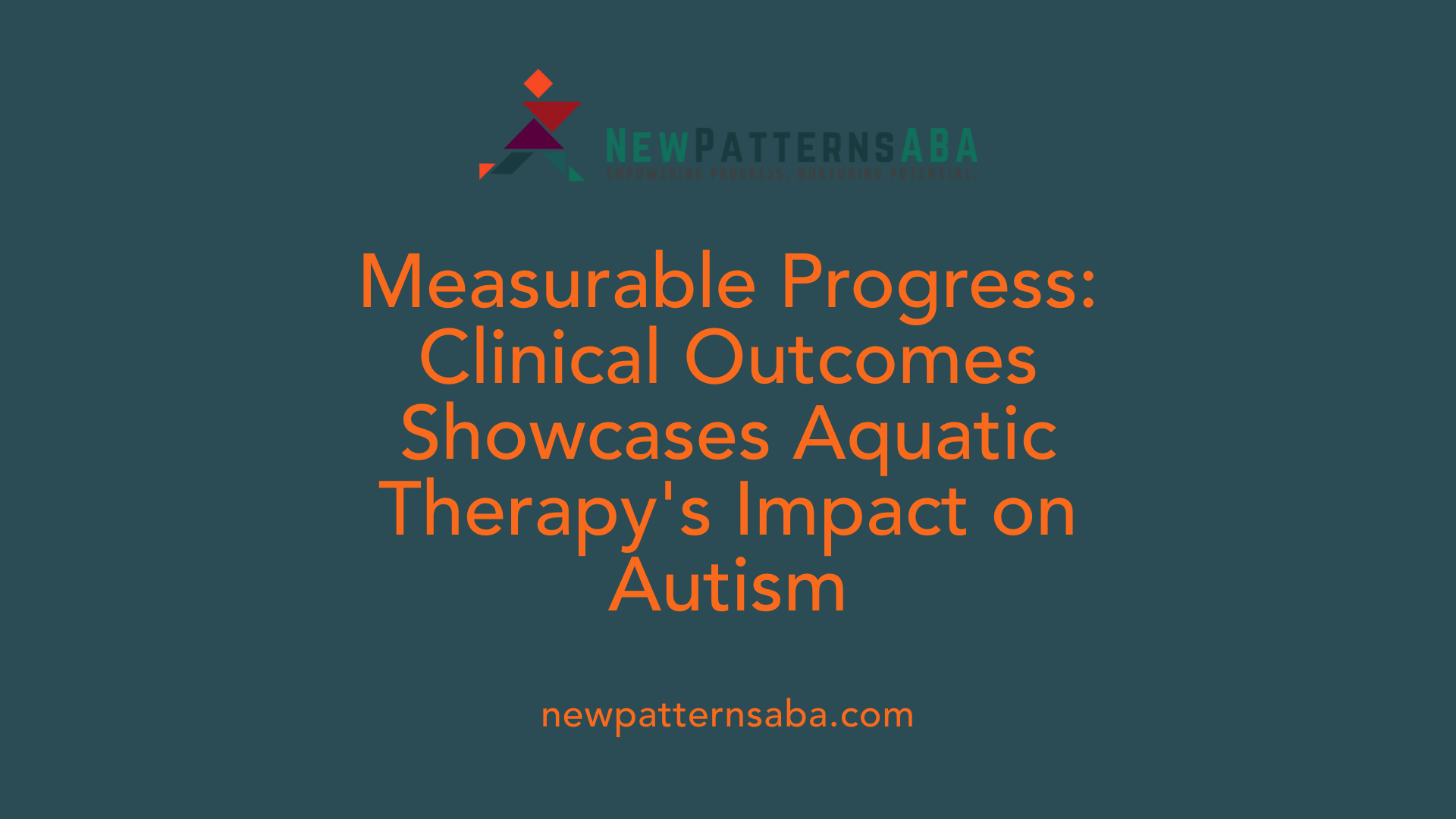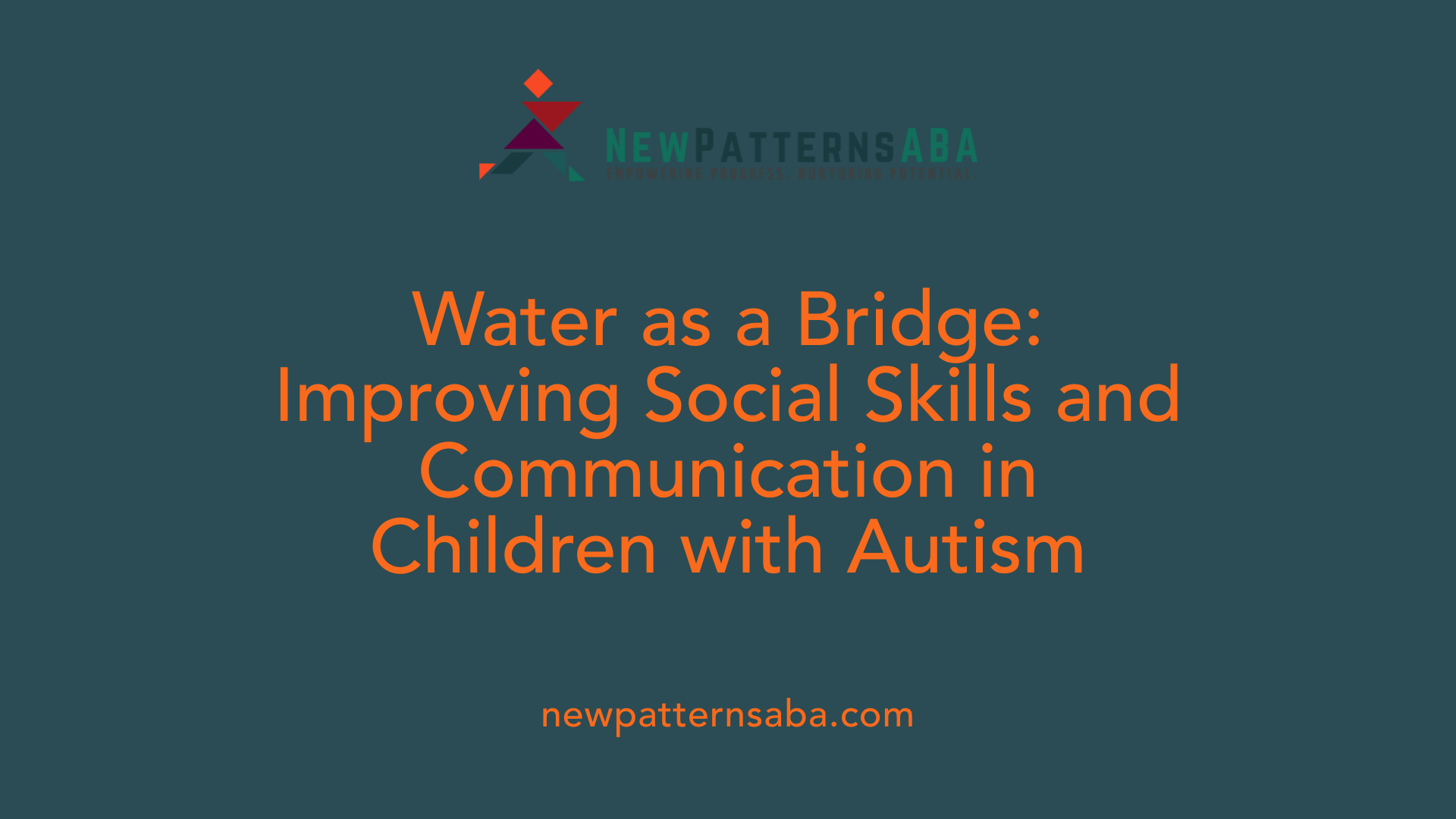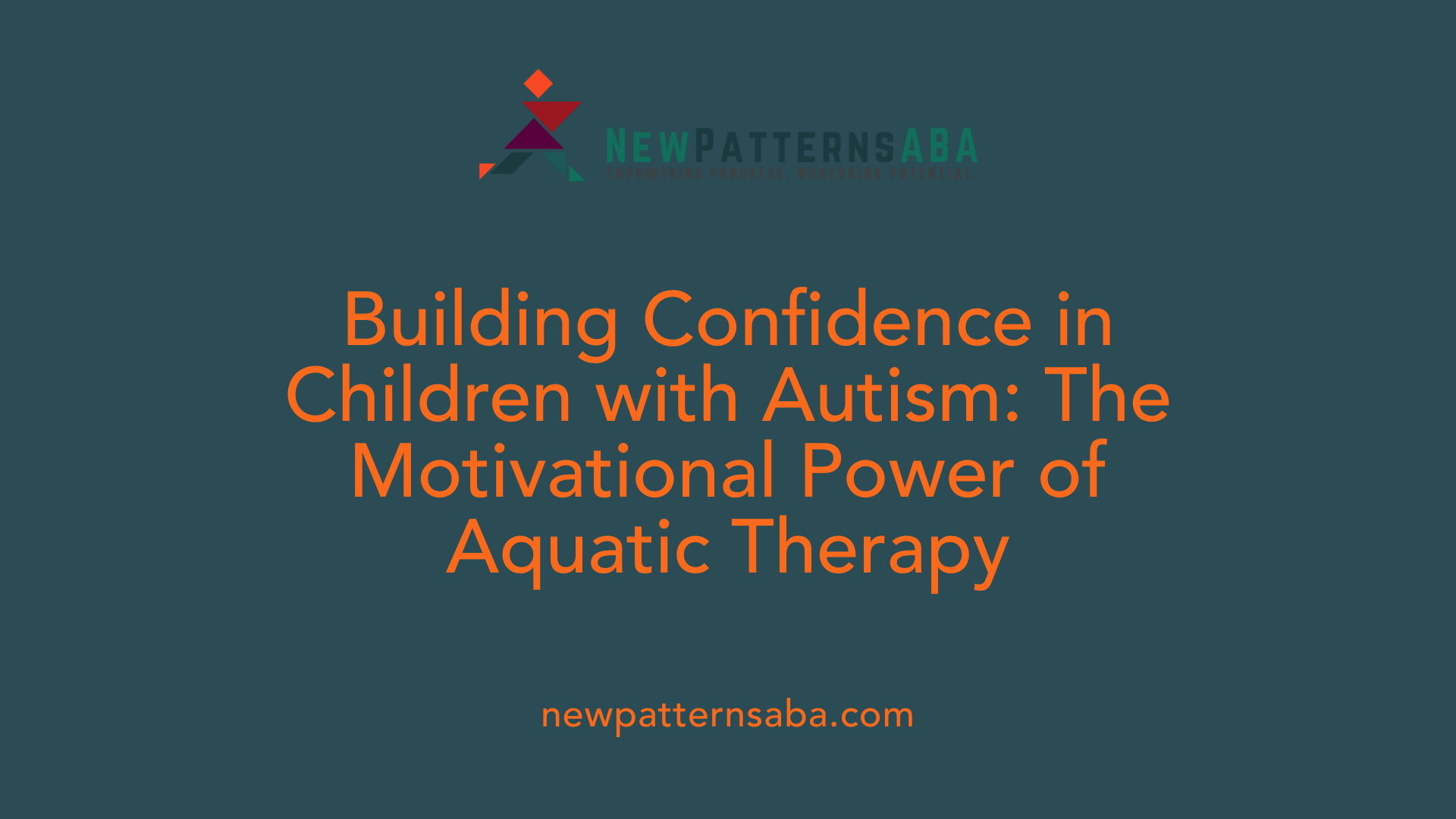Exploring Water's Role in Autism Therapy
Aquatic therapy is increasingly gaining recognition as a valuable intervention for children with autism spectrum disorder (ASD). With unique properties such as buoyancy, hydrostatic pressure, and viscosity, water provides a supportive and sensory-rich environment that can enhance physical, social, and behavioral skills. This article explores the multifaceted benefits of aquatic therapy for children with autism, examining quantitative outcomes, parental insights, and the underlying therapeutic mechanisms, while also contextualizing it within broader behavioral interventions like Applied Behavior Analysis (ABA).
Understanding Aquatic Therapy and Its Unique Therapeutic Environment

What makes aquatic therapy beneficial for children with autism?
Aquatic therapy harnesses several unique properties of water that create an ideal therapeutic environment for children with autism. Key elements like buoyancy, hydrostatic pressure, viscosity, and surface tension work together to support physical and sensory development.
Buoyancy reduces the effects of gravity, making it easier for children to maintain balance and improve postural control. This supportive effect lessens their fear of injury, encouraging them to try new movements and develop motor skills in a safe setting.
Hydrostatic pressure provides deep, even sensory input across the body, which can have a calming effect and improve sensory regulation. This pressure offers proprioceptive feedback, enhancing body awareness and muscle coordination.
Water's viscosity creates resistance, which helps build muscle strength and promotes coordination and core stability during exercises.
The water environment also delivers controlled vestibular stimulation, aiding in balance development and reducing repetitive, maladaptive behaviors such as rocking and twirling.
Together, these sensory and physical benefits promote improved self-regulation, motor skills, focus, and emotional well-being. Children who participate in aquatic therapy often show increased relaxation, better mood, and enhanced social interactions.
Sensory benefits of hydrostatic pressure and vestibular stimulation
Being submerged in water exposes children to hydrostatic pressure, which evenly distributes a comforting, deep pressure sensation. This sensory experience is especially helpful for calming children with autism and reducing their anxiety or hyperactivity. The water also provides vestibular input through movement and buoyancy, which is crucial for developing a sense of balance and spatial orientation.
These sensory inputs can reduce stereotyped movements and disruptive behaviors, helping children achieve greater focus and calmness during and after sessions.
Physical support and safety in water for children with autism
The aquatic environment offers physical support that is difficult to replicate on land. Water's buoyancy supports the body, allowing children to perform activities with less effort and risk. This support builds confidence as they overcome motor challenges without fear of falling or injury.
Additionally, water resistance strengthens muscles essential for movement and speech by providing a gentle but effective workout. The calming effect of water combined with safe, supervised conditions enables extended engagement in therapy.
By integrating sensory support with physical safety, aquatic therapy enhances children's willingness to participate and helps them develop better physical, cognitive, and social skills.
| Water Property | Therapeutic Role | Impact on Children with Autism |
|---|---|---|
| Buoyancy | Supports balance, reduces gravity's impact | Improves postural control and motor confidence |
| Hydrostatic Pressure | Provides deep pressure input | Calms anxiety, enhances proprioception |
| Viscosity | Creates resistance | Builds muscle strength, coordination, and core stability |
| Surface Tension | Assists in controlled movement | Facilitates fine motor skill practice |
| Vestibular Stimulation | Through water movement | Improves balance, reduces repetitive behaviors |
Quantifiable Improvements: Clinical Outcomes of Aquatic Therapy in Autism

What measurable outcomes have aquatic therapy programs achieved?
Clinical research on aquatic therapy for children with autism spectrum disorder (ASD) has revealed notable, quantifiable gains across various domains. One major area of improvement is perceived physical competence, where studies report significant enhancements with large effect sizes (p=0.026). These children develop stronger aquatic skills that translate into increased confidence and motor ability in the water environment.
Health-related quality of life also demonstrates marked progress, especially in school functioning, physical health, and psychosocial aspects. Structured water therapy contributes to better engagement and participation in daily activities and learning settings.
From a behavioral perspective, parents consistently observe notable changes after aquatic therapy sessions. These include decreases in stereotyped movements such as hand flapping, jumping, and rocking. Disruptive behaviors reduce, while children exhibit increased relaxation, greater calmness, and improved focus post-therapy.
Together, these measurable outcomes highlight aquatic therapy's multifaceted benefits for children with ASD, supporting both their physical development and behavioral regulation in meaningful ways.
Enhancing Social Communication and Interaction Through Water-Based Therapy

Parental Observations Regarding Communication Improvements
Parents of children undergoing aquatic therapy consistently note positive changes in their children's communication abilities. Many report enhanced non-verbal communication skills, such as increased eye contact and heightened attentiveness during social interactions. Although verbal communication improvements tend to be limited, the progression in other forms of communication is considered significant by caregivers.
Emotional Reciprocity and Increased Eye Contact
Aquatic therapy promotes emotional reciprocity, with children showing greater responsiveness to social cues and increased emotional engagement. Sessions often result in children becoming more relaxed and calm, which primes them to better participate socially. The water environment facilitates sensory regulation that supports these emotional improvements, contributing to more meaningful interpersonal exchanges.
Social Interaction Benefits and Cooperative Behaviors
Children engaged in water-based therapy typically exhibit increased social motivation and cooperation. Parents observe that their children interact more freely, participate in group activities with peers, and show reduced anxiety and disruptive behaviors post-session. The enjoyable and motivating nature of aquatic therapy encourages ongoing social participation, which is vital for developing friendships and peer relationships.
How Does Aquatic Therapy Influence Social Communication in Children with Autism?
Aquatic therapy positively influences social communication by enhancing non-verbal cues and emotional connection. The calming effects of water and structured therapy sessions encourage children to engage more deeply with others, increasing eye contact and attentiveness. These changes support better peer relationships and emotional well-being, even though verbal speech improvements may take longer to manifest. Overall, aquatic therapy fosters a supportive social environment promoting communication and interaction.
| Aspect | Observed Benefit | Description |
|---|---|---|
| Non-verbal Communication | Increased eye contact and social attentiveness | Children show more engagement through facial expression and body language during interactions. |
| Emotional Reciprocity | Enhanced emotional responsiveness | Children become calmer and more connected to social partners in aquatic settings. |
| Social Interaction | Improved cooperation and social motivation | Therapy encourages peer interaction and reduces anxiety and problematic behaviors. |
| Parental Feedback | Positive perceptions of social and behavioral gains | Parents note children appear happier, calmer, and more socially involved post-therapy. |
Aquatic Therapy As a Motivating and Confidence-Building Intervention

What is the motivational impact of aquatic therapy on children with autism?
Aquatic therapy is widely regarded as an enjoyable and motivating experience for children with autism. Parents consistently describe the sessions as fun and engaging, which encourages children to actively participate and look forward to therapy. This enjoyment is crucial because it helps reduce resistance to intervention and fosters a positive attitude toward learning.
Children’s enjoyment and motivation during aquatic therapy
The playful nature of water activities and the unique sensory environment created by properties such as buoyancy and hydrostatic pressure make aquatic therapy especially appealing. Children often show excitement and enthusiasm during sessions, which enhances their engagement. The water’s supportive qualities allow children to practice movements they might find difficult or intimidating on land in a safe and comfortable way.
Building confidence through mastery of water skills
As children develop aquatic skills, their sense of competence and self-esteem improves significantly. Overcoming challenges like balance and coordination in water helps reduce fear and anxiety, allowing children to experiment with new motor tasks confidently. This mastery extends beyond physical skills; parents observe their children becoming more socially interactive and willing to engage with peers.
Parent perspectives on therapy engagement and motivation
Parents report that their children appear happier, more relaxed, and calmer after aquatic therapy sessions. They note increases in their children’s social interactions and confidence, indicating that the therapy's benefits carry over into daily life. Although some parents initially misunderstand the therapy’s goals, they quickly recognize its motivational impact as children show heightened attention and joy during water activities.
| Aspect | Observations | Parent and Child Impact |
|---|---|---|
| Enjoyment | Children find sessions fun | Higher participation and eagerness to attend therapy |
| Confidence Building | Mastery of skills in a safe space | Boost in self-esteem and willingness to try new activities |
| Social Interaction | Increased eye contact and engagement | Improved social communication and reduced anxiety |
| Behavioral Improvements | Calmness and reduced stereotypies | Better emotional regulation and mood |
These findings emphasize aquatic therapy’s role not just as a physical intervention but as a motivating and confidence-enhancing experience that supports broader developmental progress in children with autism.
Integrating Aquatic Therapy with Applied Behavior Analysis (ABA) Approaches
What is Applied Behavior Analysis (ABA) therapy, and how does it help individuals with autism?
Applied Behavior Analysis (ABA) therapy is a scientifically-backed approach targeting skill development in individuals with autism. It employs methods such as positive reinforcement and structured teaching to encourage beneficial behaviors while reducing challenges. ABA programs are customized to the individual's needs and focus on enhancing communication, social skills, and daily living activities. Techniques like discrete trial training and naturalistic teaching are commonly used to build independence and promote meaningful progress.
How aquatic therapy complements behavioral strategies
Aquatic therapy, particularly Water Specific Therapy (WST) with learning strategies, offers a sensory-rich environment that supports many ABA goals. The properties of water—like buoyancy, hydrostatic pressure, and resistance—provide sensory input that calms and engages children with autism. This environment reduces maladaptive behaviors such as rocking or twirling and improves motor skills like balance, coordination, and body awareness.
Children often demonstrate improved mood, attention, and reduced anxiety after aquatic sessions, supporting the behavioral goals targeted by ABA. Moreover, aquatic therapy encourages social interaction, communication, and cooperation, aligning with ABA's focus on enhancing social and communication skills. The motivating, fun context of water activities can increase a child's confidence and willingness to participate in social exchanges, which is vital for ABA interventions.
Role of ABA professionals and customization of therapy
ABA professionals—primarily Board Certified Behavior Analysts (BCBAs) and Registered Behavior Technicians (RBTs)—develop and oversee individualized plans grounded in behavioral science. When integrating aquatic therapy, these professionals can collaborate with aquatic therapists to tailor activities that reinforce ABA objectives while leveraging the physical and sensory benefits of water.
This collaborative approach ensures therapies complement each other, maximizing developmental gains. Sessions can be conducted in various settings, including pools, homes, or clinics, and involve careful monitoring and adjustment based on progress. Training peer or sibling assistants during aquatic therapy also enhances social facilitation, further supporting ABA goals.
By combining ABA's systematic behavioral techniques with the sensory and physical advantages of aquatic therapy, children with autism receive a holistic intervention supporting their social, cognitive, and motor development.
Complementary Benefits: Aquatic Therapy Supporting ABA Outcomes
How aquatic therapy aids social and behavioral skills targeted by ABA
Aquatic therapy, particularly Water Specific Therapy (WST), complements Applied Behavior Analysis (ABA) by fostering social communication and interaction improvements in children with ASD. Parents report enhanced non-verbal communication, increased eye contact, and emotional reciprocity after water sessions, contributing to social skills typically targeted in ABA interventions. The calming and enjoyable nature of water therapy motivates children, leading to increased social participation and cooperative behavior, which reinforces ABA goals.
Physical and sensory benefits supporting overall therapy progress
The unique properties of water—such as buoyancy, hydrostatic pressure, and resistance—provide multisensory inputs that support motor coordination, balance, and body awareness. These benefits address frequent gross and fine motor challenges in children with ASD, enabling them to execute movement strategies more effectively. Improved muscle strength and postural control gained during aquatic therapy create a stable foundation that enhances the effectiveness of ABA techniques targeting daily living and functional skills.
Enhancing self-regulation and reducing behavioral challenges
Aquatic therapy offers deep pressure stimulation through hydrostatic pressure and controlled vestibular input, which aids self-regulation and emotional calming. These sensory supports reduce stereotypical behaviors like rocking and hand flapping and lower anxiety levels. As children become calmer and more focused post-therapy, they are better able to engage with ABA activities, improving attention spans and decreasing disruptive behaviors that often hinder therapy progress.
What are the common benefits observed in individuals receiving ABA therapy?
ABA therapy is known to improve communication skills, social interaction, and daily living independence. It effectively reduces challenging behaviors like aggression and enhances overall quality of life by promoting functional abilities and minimizing problematic conduct. When paired with aquatic therapy’s sensory and physical advantages, these outcomes can be further strengthened.
Together, aquatic therapy and ABA create a synergistic approach, where water-based sensory and motor improvements support behavioral and social skill acquisition targeted by ABA, leading to more holistic progress for children with ASD.
Safety and Skill Development: Addressing Critical Needs Through Aquatic Therapy
Water Safety and Drowning Prevention for Children with Autism
Drowning remains a leading cause of death among children with autism, making water safety an urgent priority. Aquatic therapy plays a vital role in teaching children essential water safety skills in a supportive environment. By using methods such as the Halliwick approach, therapy sessions emphasize controlled water exposure that builds confidence and familiarity. This not only promotes safety but also reduces fear, allowing children to engage with water based activities more freely and securely.
Role of Hydrotherapy in Motor and Cognitive Skill Enhancement
Hydrotherapy leverages the unique properties of water — buoyancy, hydrostatic pressure, viscosity, and surface tension — to facilitate improvements in both motor and cognitive domains. Buoyancy supports balance and postural control, while hydrostatic pressure provides sensory input that enhances body awareness and muscle strength. These factors contribute to advancements in gross motor skills like coordination and balance, as well as fine motor skills, which are challenging for many children with autism. Additionally, water resistance supports speech muscle development and cognitive functions through engaging and motivating exercises.
Involvement of Trained Peers or Siblings to Encourage Interaction
Incorporating trained peers or siblings into aquatic therapy sessions can amplify social and physical gains. The presence of familiar or relatable individuals encourages increased communication, cooperation, and social interaction during therapy. This social facilitation effect complements the physical benefits, helping children with autism not only improve motor skills but also enhance social behaviors and emotional regulation.
Aquatic therapy thus provides a multidimensional approach addressing critical safety concerns and motor skill deficits prevalent in children with autism, while fostering social engagement through inclusive, supportive settings.
Limitations and Future Directions in Aquatic Therapy Research for Autism
What are the limitations and criticisms regarding aquatic therapy research in autism?
Aquatic therapy shows promise in improving physical, social, and behavioral outcomes for children with autism spectrum disorder (ASD). However, current research is hindered by several important limitations. Many studies have small sample sizes, which restricts the generalizability of their findings and lowers statistical power. Moreover, the absence of standardized outcome measures makes it difficult to compare results or combine data across studies reliably.
Intervention protocols also vary widely, with differences in session frequency, duration, and specific therapeutic methods such as the Halliwick approach or Water Specific Therapy (WST). This variability can introduce inconsistencies that further complicate result interpretation. Additionally, some studies lack appropriate control groups or blinded assessments, contributing to potential biases.
Given these methodological challenges, the quality of evidence remains limited despite encouraging reports of benefits. Therefore, clinical recommendations regarding aquatic therapy should be adopted cautiously. More rigorous research with larger participant groups, consistent protocols, and validated outcome tools is necessary to confirm and refine therapy effectiveness.
Future studies should emphasize:
- Developing and using standardized assessments for motor, cognitive, and social outcomes
- Employing randomized controlled trial designs with adequate sample sizes
- Investigating optimal dosage and intervention components
- Including long-term follow-up to assess sustained effects
By addressing these gaps, aquatic therapy research will strengthen its scientific foundation and better guide clinical practice for children with ASD.
Conclusion: The Emerging Role of Aquatic Therapy in Autism Intervention
What are the physical, behavioral, and social benefits of aquatic therapy for children with autism?
Aquatic therapy, particularly Water Specific Therapy with learning strategies, demonstrates significant improvements in children with autism spectrum disorder (ASD). Physically, it enhances muscle strength, coordination, balance, and core stability more effectively than land exercises. The supportive properties of water—such as buoyancy, hydrostatic pressure, viscosity, and surface tension—help improve body awareness, motor skills, and range of motion while reducing fear of injury.
Behaviorally, children show reductions in stereotyped movements, sensory-seeking behaviors, and disruptive actions like hand flapping and jumping. Enhanced self-regulation and calmness often follow sessions, with longer-lasting mood improvements. Socially, children display better non-verbal communication, increased eye contact, and more engagement with peers. Parents observe improved emotional reciprocity, attention, and social cooperation post-therapy.
Why is parental involvement and motivation important in aquatic therapy?
Parents play a vital role in the success of aquatic therapy by providing valuable feedback and support. They report that water therapy sessions make their children happier, calmer, and more relaxed. Their perspectives help capture nuanced behavioral and social changes that clinical measures alone might miss. Additionally, parents note that aquatic therapy is motivating and fun for the children, increasing their confidence and willingness to participate, which is crucial for sustained progress.
How does aquatic therapy complement established behavioral therapies?
Although aquatic therapy is still underutilized, it serves as an effective complementary approach alongside traditional behavioral therapies. It adds sensory support through deep pressure and vestibular stimulation, which helps regulate self-control and reduce maladaptive behaviors. The physical exercise components further bolster cognitive functions, social skills, and emotional regulation. Importantly, aquatic therapy offers a safe, engaging environment where children can explore movement and social interaction, strengthening gains from conventional therapies.
Overall, aquatic therapy emerges as a promising multi-dimensional intervention supporting physical, behavioral, and social development in children with ASD, especially when integrated with parental involvement and existing therapeutic programs.
Making a Splash: Toward Broader Recognition and Integration
Aquatic therapy offers a unique and multifaceted approach for supporting children with autism spectrum disorder, leveraging water’s natural properties to improve physical skills, social communication, and behavioral regulation. Clinical evidence and parent reports highlight significant benefits including increased physical competence, reduced disruptive behaviors, enhanced social reciprocity, and heightened motivation and confidence. When combined with established behavioral interventions such as Applied Behavior Analysis, aquatic therapy may provide a powerful complementary tool for fostering comprehensive development. Despite some research limitations, the growing body of evidence encourages wider adoption and further study, underscoring aquatic therapy’s promise as a transformative therapeutic option for children on the autism spectrum.
References
- Effects of Aquatic Therapy for Children with Autism ...
- Aquatic Therapy for Children with Autism is Fun, Safe, and ...
- Swimming and Autism how aquatic therapy will improve ...
- The effectiveness of hydrotherapy in the treatment of social ...
- Water-based exercise therapy and improvement in the ...
- Applied Behavior Analysis (ABA)
- How to Become an ABA Therapist - School of Education
- 20 Usual and Not-So-Usual Jobs in Applied Behavior Analysis





